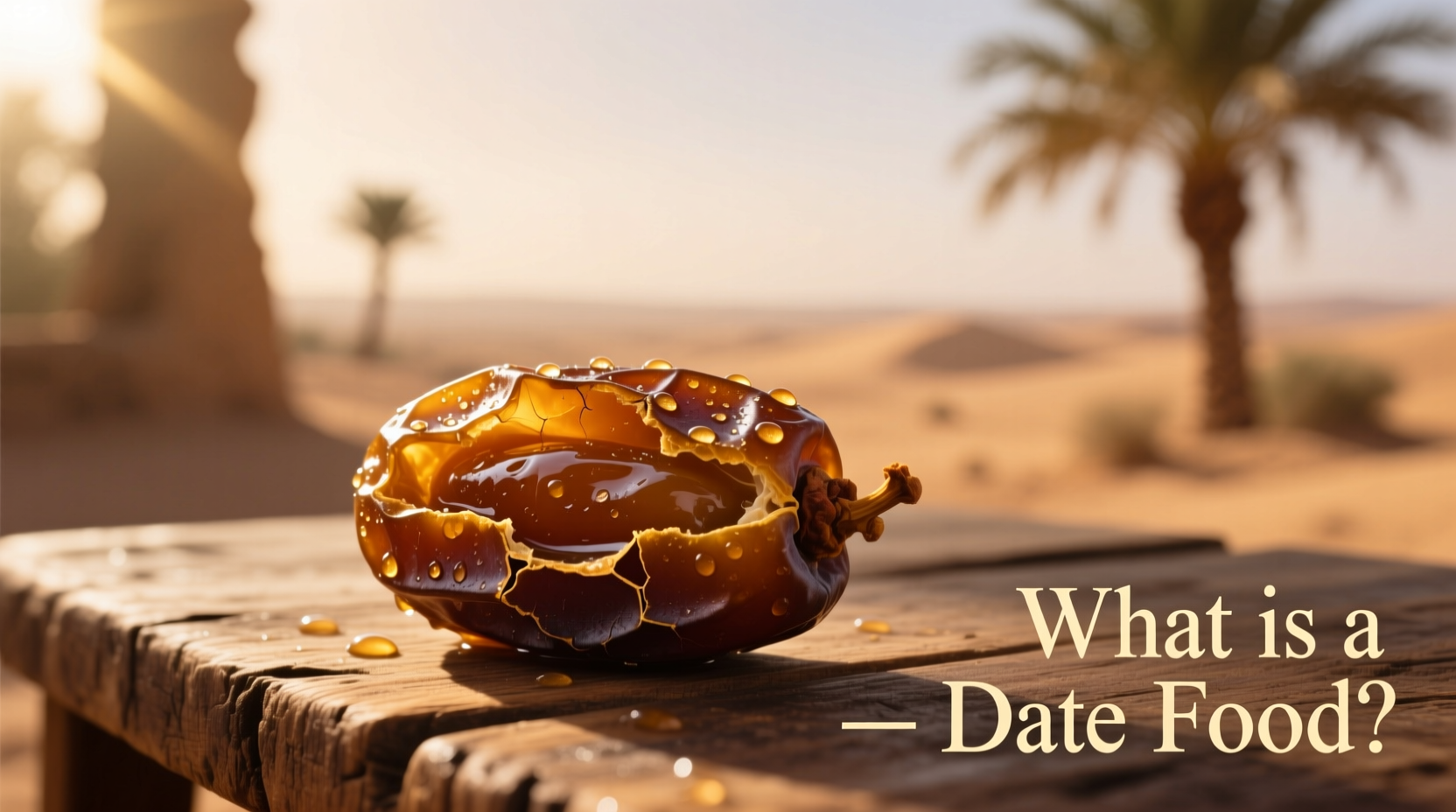When you search what is a date food, you're likely seeking clarification about this misunderstood fruit. Many confuse "date food" with meals for romantic dates, but in culinary terms, dates refer specifically to the sweet fruit harvested from date palm trees. Understanding this distinction is crucial for accessing accurate nutritional information and culinary applications.
What Exactly Are Dates?
Dates are the fruit of the date palm tree, scientifically known as Phoenix dactylifera. These oval-shaped fruits grow in large clusters and transition from yellow-green to deep brown as they ripen. Unlike most fruits, dates contain no water content when fully matured, making them naturally sweet with sugar concentrations reaching up to 60-70% of their composition.
Historical evidence shows date cultivation began in Mesopotamia around 6000 BCE. The Food and Agriculture Organization (FAO) documents dates as one of the oldest cultivated fruits, with archaeological findings confirming their importance in ancient Egyptian and Babylonian civilizations. Today, major producers include Egypt, Iran, Saudi Arabia, and Iraq, accounting for over 70% of global production.
| Nutrient | Per 100g | Daily Value % |
|---|---|---|
| Calories | 277 kcal | 14% |
| Dietary Fiber | 6.7 g | 24% |
| Potassium | 696 mg | 20% |
| Magnesium | 54 mg | 13% |
| Iron | 0.9 mg | 5% |
Nutritional data sourced from USDA FoodData Central (Release 17)
Timeline of Date Cultivation
Dates have played a significant role in human history across multiple civilizations:
- 6000 BCE: Earliest evidence of date cultivation in Mesopotamia
- 2500 BCE: Dates mentioned in ancient Sumerian and Babylonian texts
- 1500 BCE: Egyptian hieroglyphs depict date palm cultivation
- 7th Century CE: Spread to North Africa and Spain through Arab traders
- 18th Century: Introduction to California missions
- Present Day: Global production exceeds 9 million metric tons annually
Common Date Varieties You Should Know
With over 3,000 varieties worldwide, these three types dominate Western markets:
- Medjool: Known as the "king of dates," these large, caramel-flavored fruits have a soft, chewy texture. Originally from Morocco, they're now primarily grown in California and Israel.
- Deglet Noor: Translating to "date of light," these semi-dry dates have a firmer texture and honey-like sweetness. They're the most commonly exported variety from North Africa.
- Barhi: Eaten fresh when golden brown, these dates have a crisp texture and butterscotch flavor. Primarily consumed in the Middle East.
Selecting and Storing Dates Properly
Choosing quality dates requires attention to specific characteristics:
- Appearance: Look for plump, shiny fruits without excessive crystallization or mold
- Texture: Should be soft and pliable, not hard or overly sticky
- Smell: Fresh dates have a sweet, caramel-like aroma without sour notes
For storage, the University of California Cooperative Extension recommends keeping dates in airtight containers. They'll last 1-2 months at room temperature, 6 months refrigerated, or up to a year frozen. Avoid storing near strong-smelling foods as dates readily absorb odors.

Practical Culinary Applications
Dates offer versatile uses beyond snacking. Their natural sweetness makes them excellent sugar substitutes in baking, while their fiber content adds nutritional value to processed foods. Try these practical applications:
- Create date paste (1:1 ratio with water) as a natural sweetener in smoothies and baked goods
- Stuff with nuts or cheese for elegant appetizers
- Blend into energy balls or bars for portable snacks
- Add to savory tagines and rice dishes for subtle sweetness
- Process into date syrup as a healthier alternative to refined sugars
Addressing Common Misconceptions
Several myths persist about date consumption. Research from the American Journal of Clinical Nutrition confirms that despite their high sugar content, dates have a moderate glycemic index (42-55) due to their fiber content. This makes them suitable for most diets when consumed in moderation (4-6 dates daily).
Contrary to popular belief, dates aren't just for Middle Eastern cuisine. Chefs worldwide incorporate them into diverse dishes, from French patisserie to contemporary American fusion cuisine. Their natural binding properties also make them valuable in vegan cooking as egg substitutes.
Frequently Asked Questions
Are dates and红枣 the same fruit?
No, dates (from date palm trees) and红枣 (Chinese red dates or jujubes) are completely different fruits. Dates come from Phoenix dactylifera trees, while jujubes belong to the Ziziphus genus. They differ in appearance, taste, and nutritional profiles.
Can people with diabetes eat dates?
Yes, in moderation. Despite their sweetness, dates have a moderate glycemic index (42-55) due to high fiber content. The American Diabetes Association recommends 1-2 dates as part of a balanced snack, preferably paired with protein or healthy fats to slow sugar absorption.
How do you remove date pits effectively?
The easiest method is to make a shallow slit along the date's length with a small knife, then gently pull the halves apart to expose the pit. For pitted dates, simply squeeze the date from both ends toward the middle to push the pit out. Specialized date pitters are available but not necessary for home use.
Why are Medjool dates more expensive than other varieties?
Medjool dates require more labor-intensive cultivation and harvesting. They're typically hand-picked to prevent damage, have lower yields per tree, and require specific growing conditions. Their premium texture and flavor also create higher market demand compared to commercial varieties like Deglet Noor.











 浙公网安备
33010002000092号
浙公网安备
33010002000092号 浙B2-20120091-4
浙B2-20120091-4